All-In [29823]
TigerPulse: 100%
Posts: 8829
Joined: 10/31/10
|
Religious Pron - The Tower of Babel 4
May 26, 2022, 4:09 PM
|
|
…..
Wood is found all over the Middle East, just not a lot of it. They’ve got sand, mud, clay, and stone up the wazoo, but wood is truly the stuff of kings. The Egyptians prized it almost as much as gold, and so to have enough to build a boat meant you were rich AF.
Pharaoh Kufu’s Lebanon Cedar Solar Boat. Buried with him for his trip to the afterlife.
x
…..
…..
Lebanon Cedar was the most famous wood in the whole region, and everyone traded for it, Egyptians, Mesopotamians, and everyone in between. And it’s in all their stories. When Gilgamesh goes on his epic journey to obtain immortality (spoiler: he fails), he has to fight a giant monster hiding in the cedar forests of Lebanon.
Humbaba the Monster? Where are you?
x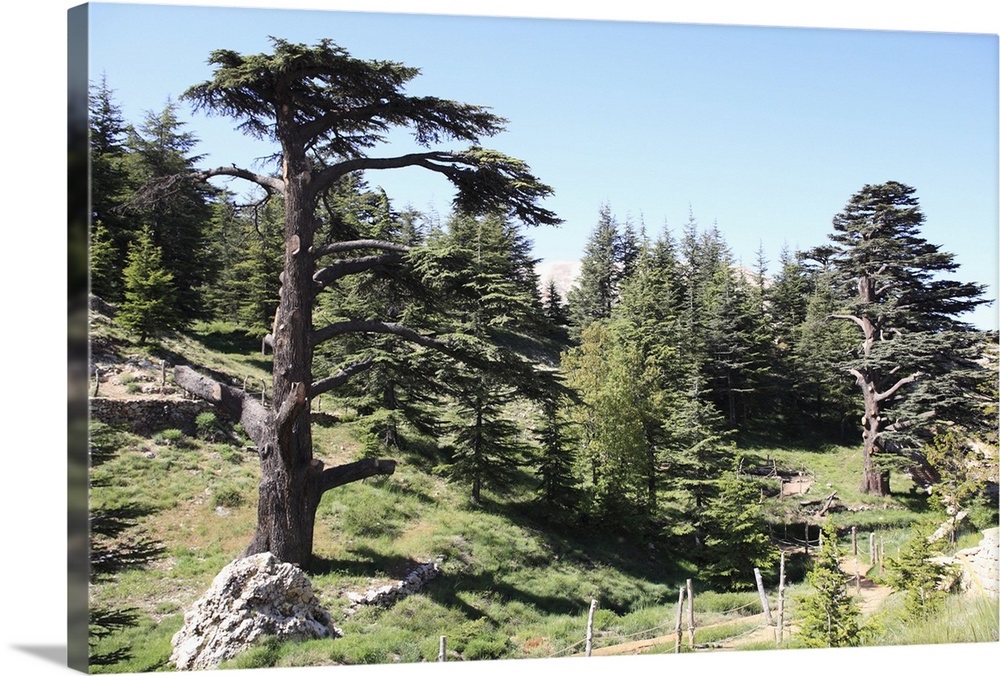
…..
…..
You don’t want to mess with Humbaba:
"When he looks at someone, it is the look of death."
"Humbaba's roar is a flood, his mouth is death and his breath is fire!
A hundred leagues away he can hear anyone in his forest!
"he had the paws of a lion and a body covered in thorny scales;
his feet had the claws of a vulture, and on his head were the horns of a wild bull;
his tail and phallus each ended in a snake's head."

…..
…..
This Brazilian amphibian doesn’t find that phallic part humorous at all. If nature finds a good model, nature re-uses that good model. Don’t be a D-head, like him, ok?

…..
…..
The Lebanese are so proud of their tree and its history they put it on their national flag.

…..
…..
Acacia was another famous wood, used to build the Ark of the Covenant, as specifically described in Exodus.


…..
…..
It makes a nice floor, too

…..
…..
And those are just a few of the woods found in the Middle East. No one knows exactly what Gopherwood is, and why you’d build an ark from it, but everybody knows about Almond, Apple, Cypress, Date Palm, Fig, Henna, Oak, Olive, Pine, Pistachio, Pomegranate, Poplar, Tamarisk, and Willow trees. We’ll get back to all these and a famous garden holding most all of them, (nothing to do with Eden) after the main poast.
Some of “The Sisters”. A grove of 16 olive trees in Lebanon, possibly 6,000 years old. If true, that would make them the oldest trees on the planet.


…..
++++++++++++++++++++++++++++++++++++++++++++++++++++++++++++++++
In the last poast I laid out the idea that the Tower of Babel story is far from being just a simple cautionary tale. It’s also a historical tale, and a Hebrew condemnation of the Neo-Babylonians under Nebuchadnezzar II.
…..
Neo-Babylonians?

…..
There were also Babylonians earlier than the ones in the Bible, and we’ll get to both the old and the “new” Babylonians once we hit the political history of Mesopotamia.
If the Neo-Babs are who the story is about, we can glean a bit more from their history. It comes through in the tone of the story but there’s no hint of it in the words themselves. And you have to know the history of the city of Babylon itself to peel away that layer of the onion.
…..

…..
Babylon, though it’s located in Mesopotamia on the Euphrates River, was originally a Semitic city established by Amorites migrating over from the Levant, by the coast of the Mediterranean. That makes them the linguistic relatives of the Hebrews themselves.
…..
That’s the Amorites at the top of the yellow where it says Amurru. You can see how they just walked right down the Euphrates River and set up shop where it says Babylon in green. An easy migration, with a water source the whole way.
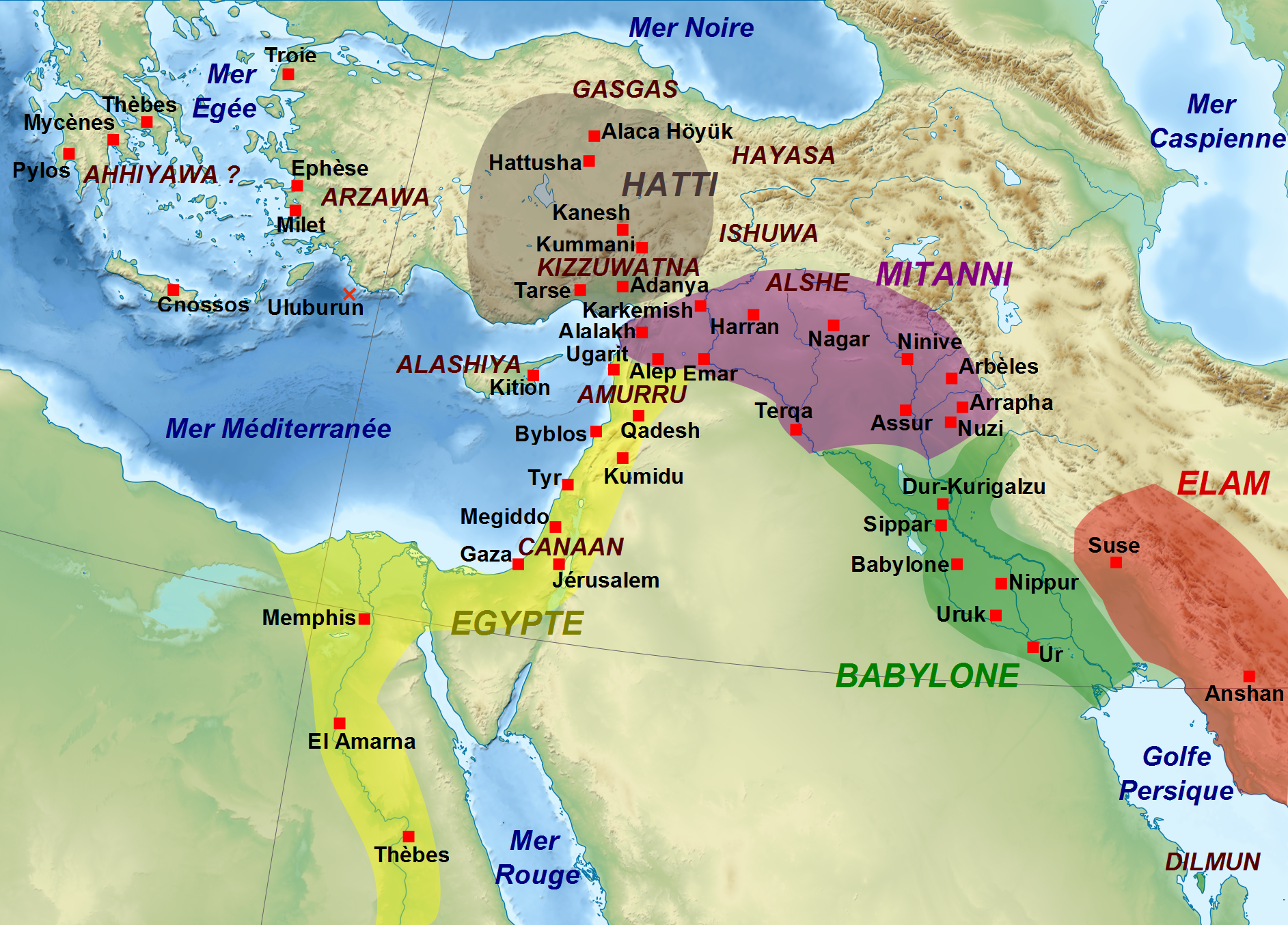
…..
…..
The Amorites were the same folks who had the cool coats of many colors like Joseph had and that Dolly Parton sang about. Dark-skinned Nubians on the left, red-skinned Egyptians in the middle, yellow-skinned Amorites on the right.

…..
…..
So you can see that the Amorites really got around all over the Fertile Crescent, which you might expect since they were nomads.
Their visit to down to Egypt was memorialized here in the tomb of the Egyptian nomarch (governor) Khnumhotep. They even brought a donkey loaded with goods and a gazelle to the shin-dig. Those party freaks!
That bare-chested Egyptian in white grabbing that gazelle by the horns looks kinda pixxed, though. “Get this GD animal out of my house! Were you Amorites raised in a barn? Sorry, a tent?”

…..
So while the author of the Tower story was angry at what Babylon had become over the centuries, and what it was currently doing by holding him captive, there is a soft-handedness in the text that feels like he’s chastising his fellow nomad cousins, not raging against mortal enemies.
…..
You broke my heart, Babylon

…..
Note that Babylon doesn’t get Sodom-ized, vaporized, razed, smashed to bits, or suffer any destruction at all in the story, really.
Yahweh simply scatters the Babylonians and sends them peacefully on their way to wander around in confusion.
…..

…..
And that soft glove is even after the Babylonians completely destroyed Judah and Yahweh’s own house, Solomon’s Temple, when they captured Jerusalem.
That kind of leniency seems strange for a God who killed every first born of Egypt and is pretty proficient at slinging fistfuls of lightning bolts at all of the enemies of the Hebrews. But a soft touch wouldn’t be strange at all if those enemies happen to both be descendants of shared relatives.
…..
Alien III spoiler alert. Why didn’t the alien kill Ripley here? Because she was bearing one of its own. Blood is a powerful connection for some folks, and for some xenomorph life-forms, too.

…..
…..
Now give your cousin a big hug

…..
Check out the rest of the story and see how gentile it is. No anger there at all.
5 “But the Lord came down to see the city and the tower the people were building.”
6 “The Lord said, If as one people speaking the same language they have begun to do this, then nothing they plan to do will be impossible for them. “
7 “Come, let us go down and confuse their language so they will not understand each other.”
8 So the Lord scattered them from there over all the earth, and they stopped building the city.
Note also that the author never uses the word arrogant anywhere in his story, despite how my Sunday School teacher may have explained it to me. Sorry, Mrs. Janecke.

Let me toss in a little more to support the idea that this story has a historical, not mythical, background.
Keep in mind that Babylon might have been the most populous city on earth at the time. Because they had conquered everything around them and were bringing in talented thinkers, craftsmen, and workers from all over (like the author), it was undoubtedly a multicultural and multilingual city.
…..

…..
So, to a Hebrew from a small homogeneous city like say, Jerusalem, who had maybe never even traveled beyond the city walls, the two things that would have really stood out in a metropolis like Babylon would be the massive construction projects and the diversity of the various enclaves.
There would have been Hebrewtown, Assyriatown, Elamtown, Jebusitetown, Moabitetown, etc., all full of different peoples. Just like the neighborhoods and skyscrapers of metropolises like New York, Chicago, LA, or Mos Eisley on Taris.
…..

…..
And those are the two things the author talks about in his story. Towers, and languages.
…..

…..
And constant construction. Noisy construction if you were the god Enlil. Alexander the Great remarked that the Etemenanki had fallen into disrepair by the time he defeated the Persians and occupied Babylon, but before that it was under constant renovation.
…..

…..
Two of the most famous reconstruction programs were under Nabopolassar and his son, Nebuchadnezzar II, who just happened to be the king who destroyed Judah and carried the exiles to Babylon. So when the author says they “stopped building the city”, it may have been his very construction project that was halted due to Cyrus’s conquest and capture of the city.
8 So the Lord scattered them from there over all the earth, and they stopped building the city.
…..

…..
And so when Babylon itself was conquered, the author would have watched all those captive, linguistic enclaves split up and go back home in their caravans, just like he did, “scattered over the face of the whole earth.” And a smart, educated linguist might have even noticed how similar the Hebrew word “bavel” (confusion, like from different languages) was to the Babylonian word “babil-im” (the gate of god), and made a clever connection between the two. Like Cootlumbia.
…..

…..
I even have an idea for who this mystery writer might be. He was an ultra-national Hebrew priest, serving IN the Temple in Jerusalem at the time. So he actually watched Solomon’s Temple be destroyed, and was hauled off to Babylon himself.
And after Cyrus freed them, he led one of the first exiled caravans back to Jerusalem. The first thing that got under his skin when he returned home was that Hebrew men were marrying foreign women, who spoke, of course, foreign languages. Scattered from Babylon to Jerusalem. And oh yeah, as a Temple priest, he was a scribe, and a proficient linguist.
His name was Ezra, and while he might not be the only candidate for the author of the Tower of Babel story, I can’t think of anyone Better Than Ezra.
…..

…..
Anyhow, Mrs. Janecke would probably take a switch to my hide for saying all this if she were still around, but it seems to me that the Tower of Babel story is more about the hard, historical, political realities of the ancient world than just being a simple morality tale. While it can be read at that level, there’s seemingly so much more to it once you get into the actual history. We may not understand it all, but the folks who read it when it was written, and who actually lived it, surely would have.
The Ancient Babylonian War Machine
…..
The winners…
:max_bytes(150000):strip_icc()/Standard-of-Ur-DETAIL-Getty501585377-5ade6a5d119fa8003736a172.jpg)
…..
…..
And the losers…
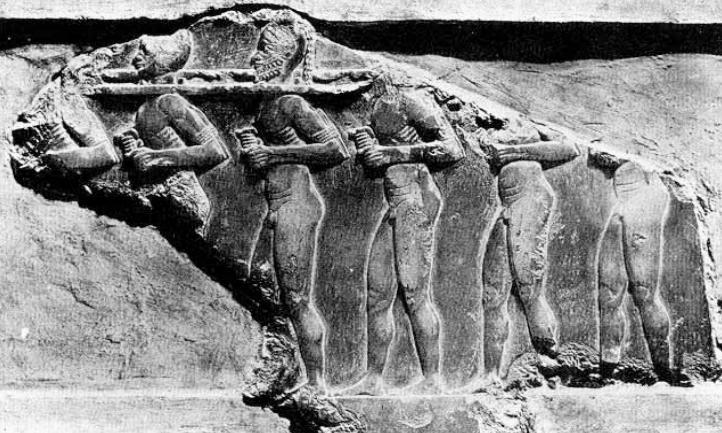
…..
That’s scary stuff, and definitely not fit for kids. Maybe my Sunday School teacher was wiser and more protective of me than I knew by shielding me from that side of the story. Thanks for looking after the tender sensibilities of my youth, Mrs. Janecke! You were the best!
…..
Now get outta here!

…..
++++++++++++++++++++++++++++++++++++++++++++++++++++++++++++++++++
…..
As long as we are in Babylon, we have to talk about the Hanging Gardens of Babylon. Not doing so would be like going to Egypt and not visiting the pyramids.

…..
…..
The legend is that that the wife of Nebuchadnezzar II missed her green, hilly homeland, so he built her a replica to keep from being homesick. The garden had all of the beautiful flowers and trees she remembered, like the ones were listed earlier, to keep her happy.
See, when Nebuch wasn’t destroying nations he could be a nice guy. Not sure which one is his wife Amytis, though. Maybe on the sofa?

…..
…..
Although the gardens have never been found, they are recounted several times in ancient literature, and even made the Greek Seven Wonders of the World list. So, using the criteria that multiple references increases the likelihood of existence, it’s pretty probable that they were actually out there, somewhere, at some time.
Here’s a lush Mesopotamian garden, complete with a severed defeated king’s head hanging like low fruit on the second tree from the left.

…..
…..
There are a few strong candidates for its location, but also some problems. The “hanging” part is presumed to mean like terraced, with plants and vines hanging over the side. That would imply a tower of some sort. And of course, in the desert you are going to need a LOT of water to sustain it, so that means a river or canal. One candidate for the Hanging Gardens of Babylon is the Etemenanki itself.

…..
…..
Another candidate is the Royal Palace in Babylonia, which unfortunately is underwater since the Euphrates River changed course centuries ago.

…..
…..
But like at Lakes Mead and Powell, there may be a silver lining to the drought. It’s much easier to discover underwater things when the water recedes.

…..
…..
The third candidate is a really interesting one though. “Babylon” could also mean a region, not just a town. Upriver at Nineveh, there is an extensive record of a garden that King Sennacherib built at his royal palace. Mainly because it was a really impressive technical feat and he bragged about it ALL THE TIME. He had pictures carved of it all over the place:
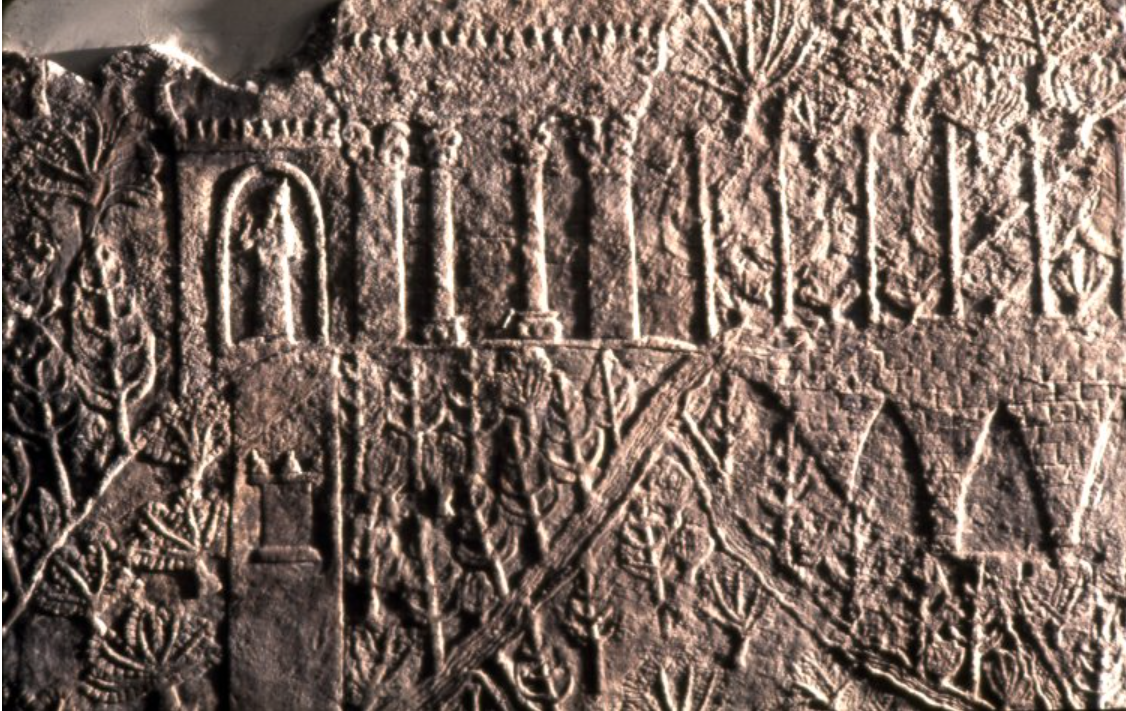
And had songs commissioned about it, and poems written about it. The guy was quite the self-promoter.
And he even built a 30 mile long canal/aqueduct from the mountains to water it, which still exists to this day, in Jerwan, Iraq, near Mosul.
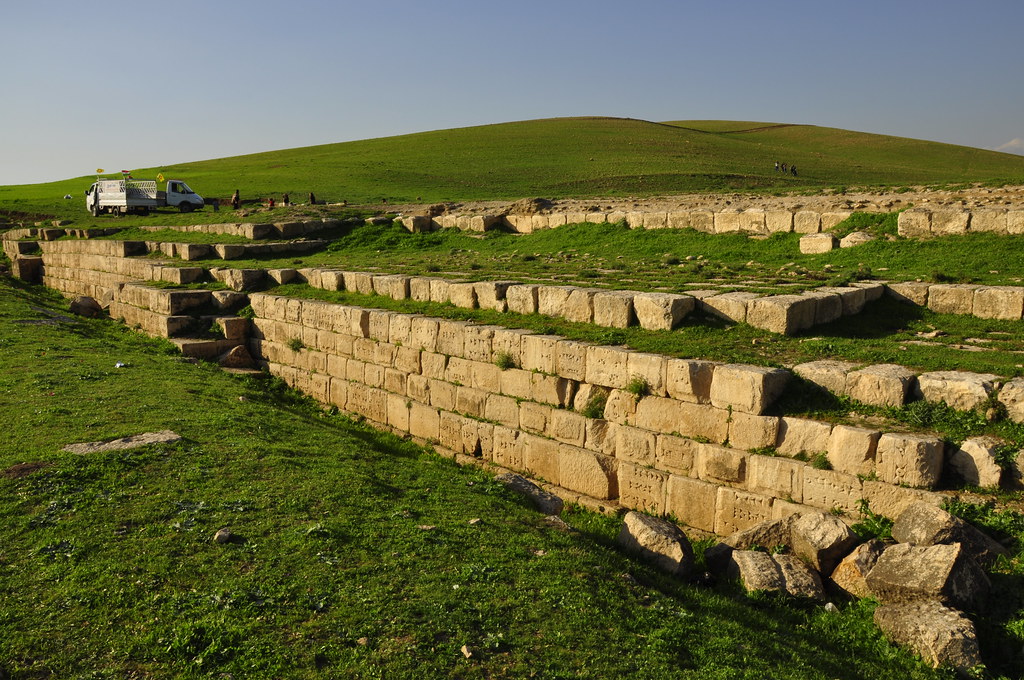
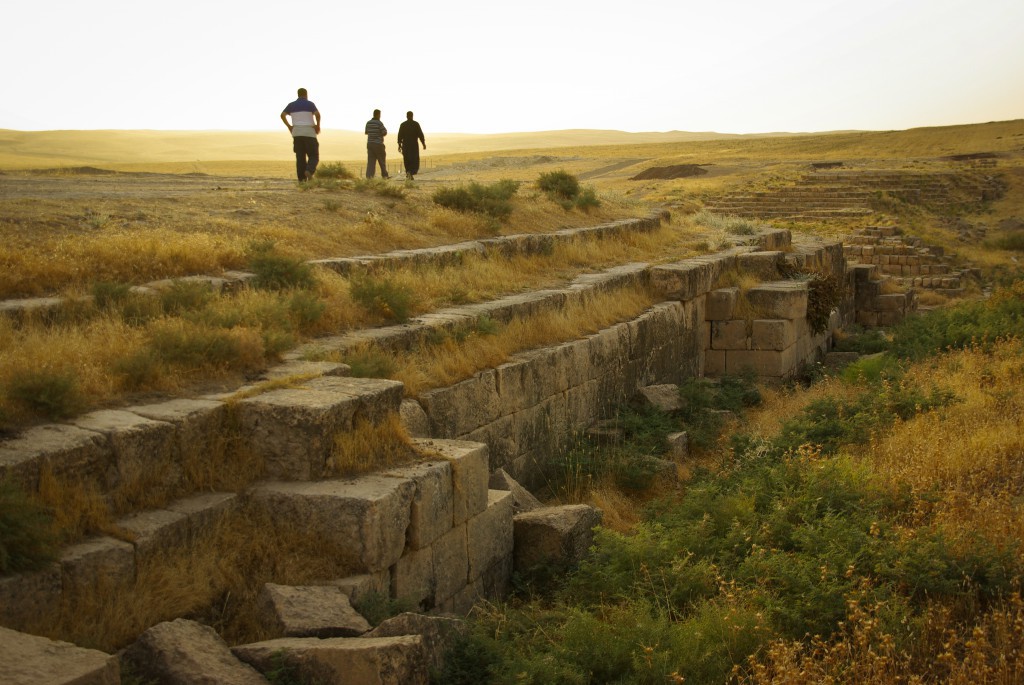


…..
…..
He was so proud of his engineering feat that he crarved himself credit on the aqueduct itself:
"Sennacherib, king of the world, king of Assyria. Over a great distance I had a watercourse directed to the environs of Nineveh, joining together the waters.... Over steep-sided valleys I spanned an aqueduct of white limestone blocks, I made those waters flow over it."
And had his canal, feeding his garden, etched in stone for posterity.
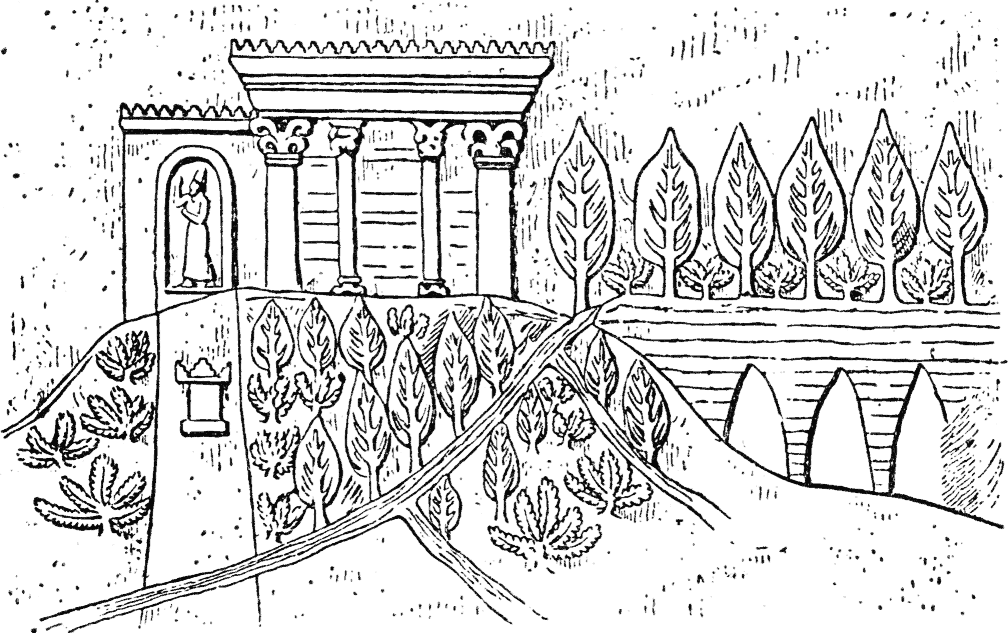
…..
So was there a real Hanging Garden of Babylon? For now, it’s all tradition.
…..

…..
…..

…..
|
|



 to award
the award.
to award
the award.



























:max_bytes(150000):strip_icc()/Standard-of-Ur-DETAIL-Getty501585377-5ade6a5d119fa8003736a172.jpg)















